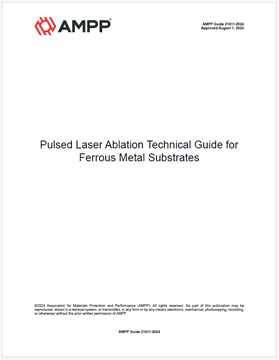This AMPP standard, designated AMPP SP21511-1, is intended to enable specifiers to develop project specification re- quirements and end users to achieve the required level of surface preparation or cleanliness using pulsed laser ablation (PLA). For the purpose of this standard, PLA employs pulsed, Q-switched laser technology.
PLA is a media-free, commercially available process that uses high-intensity directed energy in the form of a collimated, monochromatic, pulsed, focused, and scanned laser beam to remove coatings, oxides, contaminants, and hazardous materials (HAZMATs). This process is also referred to as laser ablation coating removal (LACR). PLA may be used to prepare coated or uncoated ferrous metal substrates before the application of a protective coating or lining, or it may be used in conjunction with other surface preparation methods. PLA offers environmental, health, and safety (EH&S) ben- efits as well as a level of precision that cannot be achieved with other surface preparation technologies. This standard is intended to be used by corrosion control professionals in civil infrastructure, defense, nuclear, petrochemical, auto- motive, aerospace, and other related industries. It is for use by coating specifiers, engineers, contractors, inspectors, and others who are responsible for defining a specific level of surface cleanliness or producing a post-laser treatment surface condition specified, using PLA technology.
PLA can remove 100% of existing coatings. However, it is most effective for applications requiring less than 95% of coating removal (by surface area of exposed substrate) when prescribed by appropriate Technical Authority guidance.
The primary functions of PLA cleaning applications are:
a) To remove material from the surface that can cause premature failure of the new coating system. Paragraph A1 of Appendix A (nonmandatory) provides additional information.
b) To enhance the adhesion of a new coating system.
c) To expose the surface profile of the substrate that is underneath the existing coating, rust, other corrosion products, or other contaminants and,
d) To reduce or remove nonvisible contamination that may be present on the substrate. Examples include thin films of oil and grease, and soluble ionic materials such as chlorides, ferrous salts, nitrates, and sulfates. PLA can reduce or completely remove water-soluble contaminants as well as fixed, non-smear- able low-level radiological contamination.
Product Number:
AMPP SP21511-1-2024
Publication Date:
2024
$109.00
$109.00
$109.00
Or
This AMPP standard, designated AMPP SP21511-1, is intended to enable specifiers to develop project specification re- quirements and end users to achieve the required level of surface preparation or cleanliness using pulsed laser ablation (PLA). For the purpose of this standard, PLA employs pulsed, Q-switched laser technology.
PLA is a media-free, commercially available process that uses high-intensity directed energy in the form of a collimated, monochromatic, pulsed, focused, and scanned laser beam to remove coatings, oxides, contaminants, and hazardous materials (HAZMATs). This process is also referred to as laser ablation coating removal (LACR). PLA may be used to prepare coated or uncoated ferrous metal substrates before the application of a protective coating or lining, or it may be used in conjunction with other surface preparation methods. PLA offers environmental, health, and safety (EH&S) ben- efits as well as a level of precision that cannot be achieved with other surface preparation technologies. This standard is intended to be used by corrosion control professionals in civil infrastructure, defense, nuclear, petrochemical, auto- motive, aerospace, and other related industries. It is for use by coating specifiers, engineers, contractors, inspectors, and others who are responsible for defining a specific level of surface cleanliness or producing a post-laser treatment surface condition specified, using PLA technology.
PLA can remove 100% of existing coatings. However, it is most effective for applications requiring less than 95% of coating removal (by surface area of exposed substrate) when prescribed by appropriate Technical Authority guidance.
The primary functions of PLA cleaning applications are:
a) To remove material from the surface that can cause premature failure of the new coating system. Paragraph A1 of Appendix A (nonmandatory) provides additional information.
b) To enhance the adhesion of a new coating system.
c) To expose the surface profile of the substrate that is underneath the existing coating, rust, other corrosion products, or other contaminants and,
d) To reduce or remove nonvisible contamination that may be present on the substrate. Examples include thin films of oil and grease, and soluble ionic materials such as chlorides, ferrous salts, nitrates, and sulfates. PLA can reduce or completely remove water-soluble contaminants as well as fixed, non-smear- able low-level radiological contamination.
Keywords: laser ablation, laser ablation coating removal, surface preparation, pulsed laser, laser preparation of ferrous metals, hazardous coating removal, radiological decontamination


